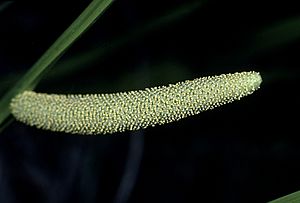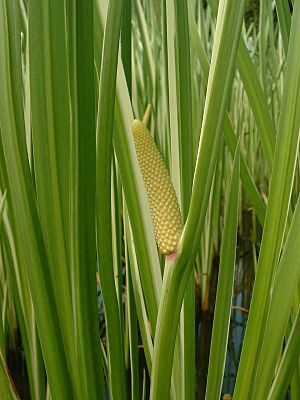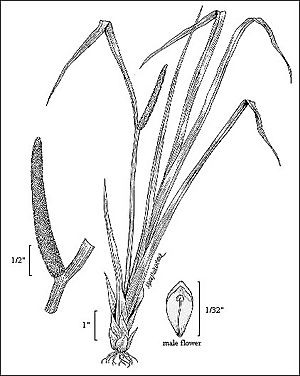Calamus facts for kids
Quick facts for kids Calamus |
|
|---|---|
 |
|
| Sweet flag Acorus calamus - spadix | |
| Scientific classification |
|
| Kingdom: | Plantae |
| Clade: | Tracheophytes |
| Clade: | Angiosperms |
| Clade: | Monocots |
| Order: | Acorales Reveal |
| Family: | Acoraceae Martinov |
| Genus: | Acorus L. |
| Synonyms | |
|
Calamus Garsault |
|
Acorus is a genus of flowering plants, often called calamus or sweet flag. These plants are a special type of monocot, which are plants that have only one seed leaf when they sprout.
For a long time, Acorus plants were thought to be part of the Araceae family (like aroids). However, scientists now know that Acorus is so unique that it has its own family, Acoraceae, and its own order, Acorales. This makes Acorus the oldest living group of monocots!
You can find Acorus plants growing naturally in North America and parts of northern and eastern Asia. They have also spread to southern Asia and Europe because people have grown them there for a very long time. Wild Acorus plants usually have two sets of chromosomes (diploid), but some in eastern Asia have four sets (tetraploid). The plants that people grow are often sterile, meaning they can't produce seeds easily. These cultivated plants usually have three sets of chromosomes (triploid) and might be a mix of the wild types.
Contents
What Makes Acorus Special?
Acorus plants have some interesting features:
- Flowers: Their flowers are small and not very noticeable. They grow on a thick, fleshy stalk called a spadix.
- No Spathe: Unlike their old relatives, the aroids, Acorus plants do not have a large leaf-like part called a spathe that wraps around the spadix.
- Leaves: The leaves are long and thin, with smooth edges. The spadix is usually 4 to 10 centimeters long and is hidden by the leaves. A special leaf-like part, called a bract, can be ten times longer than the spadix itself!
How Scientists Classify Acorus
Scientists who study plants, called taxonomists, have changed their minds about where Acorus fits in the plant family tree. Even though the Acoraceae family was first named in 1820, Acorus was often grouped with the Araceae family for many years.
But with new ways of studying plants, like looking at their DNA, scientists found that Acorus is not closely related to the Araceae family or any other monocot family. This led them to give Acorus and its family, Acoraceae, their very own order called Acorales. This means Acorus is like a "sister group" to all other monocots, showing how unique it is. The latest classification systems, like APG III and APG IV, agree with this placement.
Types of Acorus Plants
There can be some confusion about the names of Acorus species. For example, Acorus calamus is sometimes incorrectly used for Acorus americanus.
As of 2014, scientists recognize two main species of Acorus, and one of them has different varieties:
- Acorus calamus (Common sweet flag): This plant is usually sterile (can't make seeds) and has three sets of chromosomes. It probably came from cultivated plants. It grows naturally in Europe, parts of India, the Himalayas, and southern Asia. It's also widely grown and has spread to many other places.
- Acorus calamus var. angustatus: Found in places like Siberia, China, Japan, and the Himalayas.
- Acorus calamus var. calamus: Found in Siberia, Mongolia, Korea, and the Himalayas. It has also spread to Europe and North America.
- Acorus americanus: This species grows in Canada, the northern United States, and a region of Russia called Buryatiya.
- Acorus gramineus (Japanese sweet flag or grassy-leaved sweet flag): This plant can make seeds and has two sets of chromosomes. It's found in China, the Himalayas, Japan, Korea, and other parts of Asia.
Some Acorus plants from Europe, China, and Japan have also been planted in the United States.
Where the Name Comes From
The name 'acorus' comes from the Greek word 'acoron'. This name was used by an ancient Greek doctor named Dioscorides. It was linked to the word 'coreon', meaning 'pupil' of the eye. This is because Acorus was used in herbal medicine to help with inflammation of the eye.
Where Acorus Lives
These plants love wetlands, especially marshes. They spread using thick underground stems called rhizomes. Like many marsh plants, they have special air channels in their stems and roots (called aerenchyma) that help them get oxygen in watery soil. You often find them along shorelines and in areas that flood seasonally.
Acorus in Nature
The Acorus species found in North America has been studied a lot by scientists. These plants are quite good at competing with other wetland plants for space and resources. While many marsh plants store lots of seeds in the soil, Acorus might not have many seeds stored because it doesn't produce a lot of them.
Its seeds seem to grow best in open areas. After being kept cold for a while, the seeds will sprout in about seven days if they get light and the temperature changes. They take a bit longer to sprout if the temperature stays the same. One study described Acorus as a "tussock interstitial" plant. This means it grows in dense clumps and tends to fill in gaps in marsh vegetation, similar to how Iris versicolor grows.
Safety and Acorus
It's important to know that some products made from Acorus calamus were banned as food additives in the United States in 1968. This was because of a chemical called β-asarone.
However, not all types of Acorus calamus contain this chemical. There are different natural types of A. calamus plants. The types that grow naturally in Eastern Asia (like Mongolia) and North America (known as Acorus americanus) do not produce the β-asarone chemical. This means that the North American Acorus is considered safe, unlike some other types.
Uses of Acorus
The leaves of some Acorus species have parallel veins and contain special oils that give off a sweet smell when dried. In the Middle Ages, people used to spread fine-cut Acorus leaves on their floors. This was done both for the pleasant smell and because people believed it helped keep pests away.



